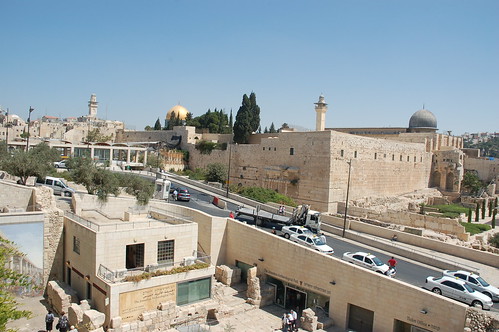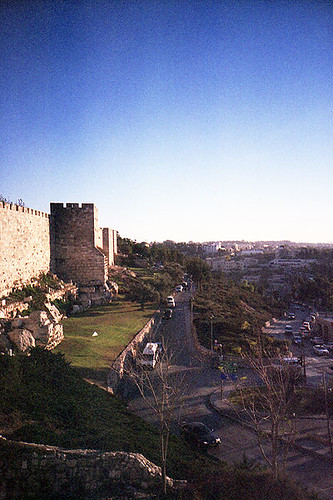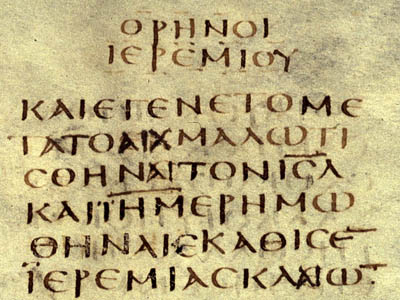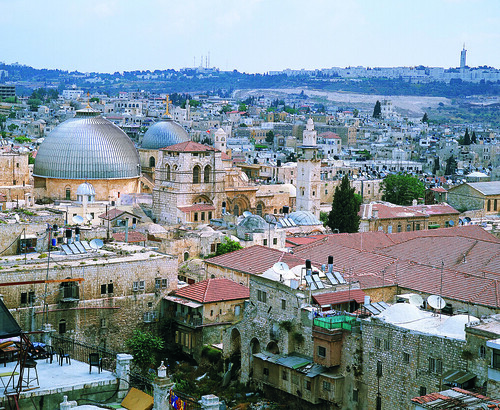History
- Early History to 1900
Despite incomplete archaeological work, it is evident that Jerusalem was occupied as far back as the 4th millenium B.C. In the late Bronze Age (2000–1550 B.C.), it was a Jebusite (Canaanite) stronghold. David captured it (c.1000 B.C.) from the Jebusites and walled the city. After Solomon built the Temple on Mt. Moriah in the 10th cent. B.C., Jerusalem became the spiritual and political capital of the Hebrews. In 586 B.C. it fell to the Babylonians, and the Temple was destroyed.
The city was restored to Hebrew rule later in the 6th cent. B.C. by Cyrus the Great, king of Persia. The Temple was rebuilt (538–515 B.C.; known as the Second Temple) by Zerubbabel, a governor of Jerusalem under the Persians. In the mid-5th cent. B.C., Ezra reinvigorated the Jewish community in Jerusalem. The city was the capital of the Maccabees in the 2d and 1st cent. B.C.
After Jerusalem had been taken for the Romans by Pompey, it became the capital of the Herod dynasty, which ruled under the aegis of Rome. The Roman emperor Titus ruined the city and destroyed the Temple (A.D. 70) in order to punish and discourage the Jews. After the revolt of Bar Kokba (A.D. 132–35), Hadrian rebuilt the city as a pagan shrine called Aelia Capitolina but forbade Jews to live on the site.
With the imperial toleration of Christianity (from 313), Jerusalem underwent a revival, greatly aided by St. Helena, who sponsored much building in the early 4th cent. Since that time Jerusalem has been a world pilgrimage spot. Muslims, who believe that the city was visited by Muhammad, treated Jerusalem favorably after they captured it in 637, making it the chief shrine after Mecca. From 688 to 691 the Dome of the Rock mosque was constructed.
In the 11th cent. the Fatimids began to hinder Christian pilgrims; their destruction of the Church of the Holy Sepulcher helped bring on the Crusades. Jerusalem was conquered by the Crusaders in 1099 and for most of the 12th cent. was the capital of the Latin Kingdom of Jerusalem. In 1187, Muslims under Saladin recaptured the city. Thereafter, under Mamluk and then Ottoman rule, Jerusalem was rebuilt and restored (especially by Sulayman I); but by the late 16th cent. it was declining as a commercial and religious center.
In the early 19th cent., Jerusalem began to revive. The flow of Christian pilgrims increased, and churches, hospices, and other institutions were built. Jewish immigration accelerated (especially from the time of the Egyptian occupation of Jerusalem by Muhammad Ali in 1832–41), and by 1900, Jews made up the largest community in the city and expanded settlement outside the Old City walls.
- The Twentieth Century
In 1917, during World War I, Jerusalem was captured by British forces under Gen. Edmund Allenby. After the war it was made the capital of the British-held League of Nations Palestine mandate (1922–48). As the end of the mandate approached, Arabs and Jews both sought to hold sole possession of the city. Most Christians favored a free city open to all religions. This view prevailed in the United Nations, which, in partitioning Palestine into Arab and Jewish states, declared that Jerusalem and its environs (including Bethlehem) would be an internationally administered enclave in the projected Arab state. Even before the partition went into effect (May 14, 1948), fighting between Jews and Arabs broke out in the city. On May 28, the Jews in the Old City surrendered. The New City remained in Jewish hands. The Old City and all areas held by the Arab Legion (East Jerusalem) were annexed by Jordan in Apr., 1949. Israel responded by retaining the area it held. On Dec. 14, 1949, the New City of Jerusalem was made the capital of Israel.
In the Arab-Israeli War of 1967, Israeli forces took the Old City. The Israeli government then formally annexed the Old City and placed all of Jerusalem under a unified administration. Arab East Jerusalemites were offered regular Israeli citizenship but chose to maintain their status as Jordanians. Israel transferred many Arabs out of the Old City but promised access to the holy places to people of all religions. In July, 1980, Israel's parliament approved a bill affirming Jerusalem as the nation's capital. With suburbanization and housing developments in formerly Jordanian-held territory, Jerusalem has become Israel's largest city. Strife between Arabs and Jews persists. The issue of the status of East Jerusalem, annexed by Israel but regarded by Palestinians as the eventual capital of their own state, remains difficult. In 1998, Israel announced a controversial plan to expand Jerusalem by annexing nearby towns.
Overview
Few cities inspire as much passion as Jerusalem (Yerushalayim in Hebrew, Al-Quds in Arabic), rooted deep in the past and revered by three major religions.
With its pleasant, temperate climate, fine upland setting, extraordinary historical sites and world-class museums, Jerusalem fascinatingly contrasts ancient and modern, oriental and western.
The larger part of the city, including the city center with its shopping and leisure district, is vibrant, Jewish West Jerusalem, characterized by broad avenues, busy pedestrianized streets and squares, cafes, restaurants and vivacious nightlife. Smaller East Jerusalem, predominantly Arab, is a 19th-century neighborhood lying north of the Old City. It has a slow but chaotic pace of life, with crowded, colorful street markets.
The Old City, on the eastern boundary, is where most of Jerusalem's main sights are found. Enclosed within awesome 16th-century stone walls, are a labyrinth of winding lanes where visitors to the city spend much of their time.
The Old City is divided into quarters, named after its four major communities in the 19th century: Arab, Jewish, Christian and Armenian, and preserving those sharp distinctions to this day. Within minutes, you may wander from calm squares where Jewish children play under the watchful eye of their mothers, to the hustle and bustle of an Arab souk, and into a tranquil Armenian garden, before arriving at the splendor of a medieval citadel.
Jerusalem came into being over 3000 years ago as the site of the Jewish Temple. The Western (or Wailing) Wall at the foot of Temple Mount is all that survives of the Temple, destroyed by the Romans, yet it remains Judaism's most revered place of prayer.
Extensive restoration and archaeological exploration gives astonishing insight into the structure and layout of the vast Temple in the time of Jesus.
For Orthodox and Catholic Christians, the Church of the Holy Sepulchre encloses the site of the Crucifixion and tomb where Jesus was laid, having carried the cross here along the Via Dolorosa.
The Muslim's beautiful gilded Dome of the Rock on Temple Mount is Jerusalem's most iconic landmark, while Al-Aqsa mosque, beside it, is proclaimed Islam's third holiest shrine.
Israel declared Jerusalem its capital in 1950 but this is not internationally recognized. Most national institutions are in West Jerusalem, part of the state of Israel since the War of Independence following its creation in 1948. East Jerusalem and the Old City were first annexed by Jordan in 1948, then in 1967 by Israel, which integrated them into a reunited Jerusalem.
- Sightseeing Overview
The compact size of Israel means that almost anywhere (with the exception of Eilat) is accessible for a day trip from Jerusalem. The coastal cities of Tel Aviv, Akko and Haifa, or the coastal ruins of ancient Caesarea, can easily be visited in a day, as can the area around the Sea of Galilee. There is enough to see in most of these places to merit a longer visit but, in terms of historical and religious sites, there is little to match Jerusalem.
The first stop for any visitor has to be the Old City, which contains the sacred sites that have caused such turmoil and unrest. It's divided into quarters (the Armenian, Christian, Jewish and Muslim) each with its unique identity and character.
When sightseeing or just exploring, visitors should be aware of the intense campaign of terrorism being waged against Israel. Popular crowded venues, such as busy street markets, restaurants and cafes, crowded buses, discos, have especially been targeted by suicide bombers.
Security guards have now been posted at the doorways or entrances to most such locations and it is advisable to be wary of venues that have not put any security measures in place. To date, tourist sights have not been struck by the bombers, and Arab areas or Muslim sites are of course unlikely to be hit.
Tourist Information
Israeli Government Tourist Office (IGTO)
Tourist Information Center, Jaffa Gate, Old City.
Tel: (02) 628 0382.
Website: www.jerusalem.muni.il
Opening hours: Sun-Thurs 0830-1545, Fri 0830-1245.
Passes
A two-day pass for the 99 bus, which gives a guided tour of the city, will allow discounted entry to the Israel Museum, Tower of David Museum and the Biblical Zoo. It can be bought at ticket offices at these sites or from the bus drivers (see Bus Tours in Tours of the City).
Key Attractions:
Temple Mount
Temple Mount (Har Habayit in Hebrew, Al Haram ash-Sharif in Arabic), also called Mount Moriah, is sacred to both Islam and Judaism. It is a natural hill, which was built up artificially to support the huge Jewish Temple that stood here for a thousand years in Biblical times. Temple Mount has remained the focus of the Jewish religion ever since - when praying, Jews worldwide still face Temple Mount.
It was from a black rock within the complex, that, according to the Koran, Muhammad made his ascension to Heaven at the conclusion of his dreamt ‘Night Ride' from Mecca, and, according to the Bible, it was here that Abraham offered Isaac for sacrifice. With the arrival of Islam in the seventh century, the octagonal, blue-tiled Dome of the Rock, with its huge gold dome, was built over the large black rock. Dominating the skyline of the Old City, its dome glinting in the sunshine, this beautiful building is Jerusalem's most famous landmark and an absolute must for visitors.
Also on Temple Mount is the Al Aqsa Mosque, the oldest mosque in Israel and (unlike the Dome of the Rock) an actual place of Muslim worship. Its silver dome dates from the 11th century. The Islamic Museum, the third building within the complex, contains Islamic artifacts and relics. Only one of the 10 gates to the complex, Al-Mughradia (Moors) gate, allows entry for non-worshippers. This is located to the right of the Western Wall and is accessed from Western Wall Plaza.
Access from Western Wall Plaza (Old City)
Website: www.al-aqsa.com (Muslim site) or www.templemount.org (Jewish site)
Opening hours: Closed during all prayer times (variable); otherwise Sun-Thurs 0730-1030 and 1230-1330; Sun-Thurs 0730-1030 (during Ramadan); closed to non-Muslims Fri and Muslim holidays. During periods of tension, the site may be closed.
Free admission for Temple Mount; charge for Dome of the Rock, Al Aqsa Mosque and Islamic Museum combined ticket.
Western Wall
Situated along one side of a vast plaza at the bottom of Temple Mount is the historic Western Wall (HaKotel in Hebrew). Also historically known as the Wailing Wall (a name offensive to some Jews) from the sounds of Jews chanting lamentations on Tisha b'Av, the annual fast, mourning the destruction of the Temple. The Western Wall, constructed of massive rough blocks of golden stone, is a remnant of the outer retaining walls of the Second Temple as reconstructed by Herod in 30BC (the First Temple, constructed by Solomon, occupied the same site but was destroyed by the Babylonians).
Since the final complete destruction of the Temple by the Romans in AD70, the Western Wall has been the holiest place of prayer for the Jewish people. Jews come from all over the world to pray or to contemplate. Some place notes with hopes, dreams and messages of goodwill in the cracks of the Wall. In keeping with Orthodox Jewish practice (because the entire site is technically an Orthodox synagogue) the length of the Wall has been divided into separate sections for men and women. Any man or woman may enter their respective section, provided men have their heads covered (visitors can borrow a kippah or skullcap when entering) and women are modestly dressed. The Wall can be reached either through the Dung Gate or through the Jewish Quarter of the Old City.
Western Wall Plaza (Old City)
Opening hours: Daily 24 hours.
Free admission.
Citadel or Tower of David
The tall, slender stone tower rising elegantly from the ancient walls of the Old City is almost as familiar an image of Jerusalem as the Dome of the Rock. But despite its name, the citadel has nothing to do with King David (the city's founder) and was in fact constructed in the first century BC, as a fortress for Herod the Great. It has therefore formed part of Jerusalem's defense structure for over 2,000 years. What remains today is largely medieval. It now houses the outstanding Museum of the History of Jerusalem, which vividly chronicles the entire history of the city. The Citadel's tallest tower, the Phasael, offers a superb panorama over the Old City. The main entrance is adjacent to Jaffa Gate.
Beside Jaffa Gate (Old City)
Tel: (02) 626 5333.
Website: www.towerofdavid.org.il
Opening hours: Sat-Thurs 0900-1700, Fri 0900-1400 (Apr-Oct); Sat-Thurs 1000-1600, Fri 1000-1400 (Nov-Mar).
Admission charge.
Via Dolorosa
The Via Dolorosa (literally ‘Road of Sorrow') is the route believed to have been walked by Jesus as he carried the Cross to his crucifixion at Calvary or Golgotha. The route begins at the Lion's Gate, passes through the Muslim Quarter and leads to the Calvary in the Church of the Holy Sepulchre. It is marked along the way by the 14 Stations of the Cross. The stations indicate events along the journey and at some of these points churches have been founded. Every year, tens of thousands of pilgrims walk this route in the belief that they are following in the footsteps of Christ.
Old City
Opening hours: Daily 24 hours.
Free admission.
Church of the Holy Sepulchre
Containing the last five Stations of the Cross of the Via Dolorosa, this is the holiest Christian site in Jerusalem. Upon entering the church, the little stairway to the right lead to the Chapel of Golgotha and three Stations of the Cross - where Jesus was stripped, crucified and removed from the cross. The Sepulchre itself is at the center of the church and marks where Jesus is believed to have been buried and resurrected. Downstairs is the Angel's Chapel, where the resurrected Christ made known himself to Mary Magdalene. The site of the church was first chosen in the fourth century by Queen Helena and the existing structure dates mainly from the period of the Crusades. It is divided into sections, which are each under the jurisdiction of a different Christian denomination. Protestants do not accept that this was the site of the Crucifixion or Resurrection.
Christian Quarter Road (Old City)
Tel: (02) 627 3314.
Opening hours: Daily 0530-2100 (summer); daily 0430-2000 (winter).
Free admission.
Yad Vashem
The name of this, the world's most important Holocaust memorial, means ‘A Hand and a Name', the word hand also meaning ‘memorial' and implying that every victim will be individually remembered. Yad Vashem (or the Holocaust Martyrs' and Heroes' Remembrance Authority) is located on the western edge of Jerusalem. It is best known as a monument to the devastation wreaked upon the Jewish people by the Nazis during WWII. There are indoor and outdoor exhibits, including museums, memorials, sculpture and a research and documentation center. The tree-lined Avenue of the Righteous Among the Nations commemorates and honors gentiles who risked their lives to save Jews and leads to the Historical Museum, Yad Vashem's prism-like central concrete structure lying mainly below ground, where the course of Hitler's ‘Final Solution' is traced.
The Hall of Remembrance is a solemn tent-like structure that allows visitors to pay their respects to the dead. Also contained within the Yad VaShem complex is the wooded, walled Valley of the Communities, recording the names of Jewish communities wiped out in their entirety, and the Hall of Names, where the names and details of over three and a half million individual victims have been recorded and are being constantly added to. There is also a poignant Art Museum, containing work produced by Jewish inmates of the death camps. Possibly the most moving, however, is the Children's Memorial, where, in a dark underground chamber, names from the list of 1.5 million children murdered in the Holocaust are constantly read out.
Har Hazikaron (near Mount Herzl, western edge of the city)
Tel: (02) 644 3400.
Website: www.yadvashem.org
Opening hours: Sun-Thurs 0900-1700 (2000 on Thurs), Fri 0900-1400.
No entry under 10 years old (including babies).
Free admission.
The Israel Museum
The Israel Museum is the nation's leading showcase for its archaeology, anthropology and art. It houses a vast number of fascinating exhibits relating to the long history and culture of the Jews in the region. Among the highlights are the modern sculptures of the Art Garden, the 20th-century artworks of the Art Pavilion, and the Archaeological Galleries, where major discoveries are displayed. In the Ethnography and Judaica wing, exhibits include a collection of ancient Jewish artifacts. A Youth Wing features hands-on activities for families and art classes for children.
The museum's greatest treasure is contained in a striking separate building called the Shrine of the Book. Resembling the lid of an earthenware jar, this structure was created to hold and display the Dead Sea Scrolls and other ancient manuscripts. Discovered beside the Dead Sea at Qumran in 1947, the Scrolls consist of the oldest known scripts of the Torah or Pentateuch (the first five books of the Old Testament), as well as the enigmatic scrolls of an austere, scholarly Jewish sect apparently resident at Qumran.
Ruppin Boulevard (near the Knesset, western edge of the city)
Tel: (02) 670 8811.
Website: www.imj.org.il
Opening hours: Mon, Wed, Sat and holidays 1000-1600, Tues 1600-2100, Thurs 1000-2100, Fri 1000-1400.
Admission charge.
Further Distractions:
Mount of Olives

Rising beyond the city walls, to the east of Temple Mount, the Mount of Olives is part of the range of hills surrounding Jerusalem. The olives that gave the place its name were cut down in Roman times and the western slope is now covered by the white tombs of the largest Jewish cemetery in the world. Tragically, it was badly vandalised during the Jordanian occupation (1948-1967), when the stones were smashed and defaced and many were removed to be used for construction. Among both Jews and Christians, the traditional belief is that the resurrection of the dead will begin on the Mount of Olives. The mountain has added religious significance for Christians, as the place Jesus came on the night before his arrest and trial. The Garden of Gethsemane, which Jesus visited after the Last Supper, lies at the foot of the slope. The supposed tomb of his mother, Mary, is a Byzantine and Crusader structure reached through a fine doorway that leads to an underground shrine containing various tombs. Although medieval, these are claimed to be the actual graves of Joseph and Mary and her parents. At the summit of the mount, an Arab village named Et-Tur affords a stunning panorama of the Old City.
Mount of Olives (East Jerusalem)
Opening hours: Daily 24 hours.
Free admission.
Montefiore Windmill

Built by Anglo-Jewish philanthropist, Sir Moses Montefiore, in 1858, the windmill is one of the oldest and most famous landmarks outside the Old City. With the windmill and two rows of houses he set about establishing the first Jewish district outside the walls of the Old City, which he called Mishkenot Sha'ananim (peaceful dwellings), but which is now called Yemin Moshe. The windmill was damaged during the 1948 War of Independence, when the British attempted to blow it up. Today it has been restored by the Jerusalem Foundation, which plans to create an open air museum and visitors' center close by.
Yemin Moshe (West Jerusalem)
Opening hours: Sun-Thurs 0900-1600, Fri 0090-1300.
Free.













 7:28 AM
7:28 AM
 crkota
crkota







 Posted in:
Posted in: 


1 comments:
Jerusalem is rich in historical heritage and culture. No wonder that a lot of tourists really like to visit the old city, and Israel's tourism is on a constant rise. Fortunately, there are a lot of Jewish tours to Israel which make it possible for most people to have a chance of visiting the Holy Land.
Last year, my best friend Tom had his vacation trip to Nazareth with his family. They celebrated his son's Bar Mitzvah there. They availed their Jewish tours of Israel early, avoiding any unnecessary delays.
Thanks so much for this very informative post!
Post a Comment